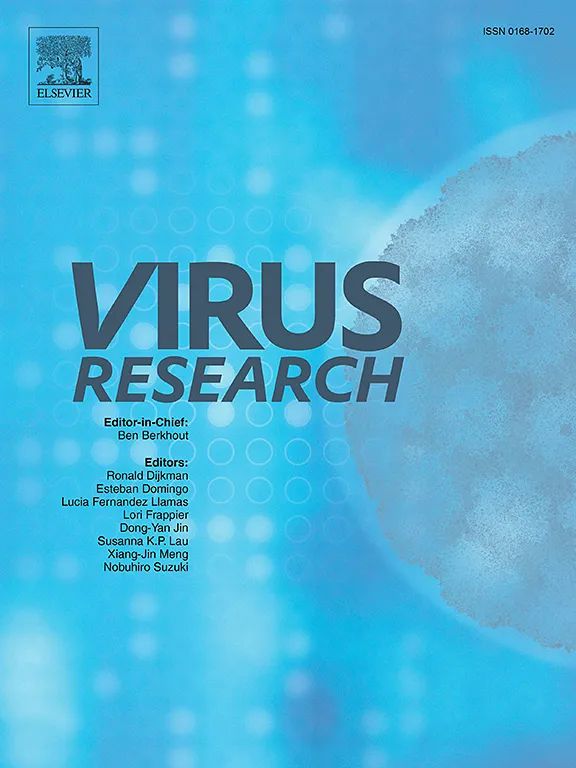腺相关病毒2 CRISPR/ cas9介导的乙型肝炎病毒在树鼩中的靶向性研究
IF 2.7
4区 医学
Q3 VIROLOGY
引用次数: 0
摘要
慢性乙型肝炎病毒(HBV)感染是一个全球性的健康问题,由于病毒遗体DNA (cccDNA)的持续存在,治疗选择有限。在此之前,我们研究了腺相关病毒2 (AAV2)载体介导的从16种grna中选择的3种引导(g) rna /Cas9的递送效果。AAV2/WJ11-Cas9在体外和人源化嵌合小鼠肝脏中有效抑制HBV复制。在本研究中,我们检测了AAV2/WJ11-Cas9对免疫能力强的北方树鼩(Tupaia belangeri;(下称“tupaia”)模型。AAV2/WJ11-Cas9治疗在感染后1,7,10和14天(dpi)显著降低血清HBV病毒载量。HBV-F感染引起肝细胞增大和小叶间结缔组织轻度淋巴细胞浸润。因此,病毒损害肝细胞并驱动感染进展和HBV核心抗原(HBcAg)积累,而这在AAV2/WJ11-Cas9治疗和正常肝组织中未观察到。AAV2/WJ11-Cas9治疗降低了肝组织中的HBV DNA和cccDNA,以及14 dpi时血清中HBV表面抗原和HBV核心相关抗原(HBcrAg),包括HBcAg和HBeAg的水平。同时检测抗hbc、抗hbs和抗aav抗体的产生。AAV2/WJ11-Cas9处理可抑制炎症因子和TLR1、TLR2、TLR3、TLR4、TLR6、TLR7、TLR9 mRNA水平。因此,通过AAV2载体传递的WJ11/Cas9可能为免疫动物模型抑制HBV感染提供了一种新的治疗方法,可以通过进一步的转化研究开发用于人类。本文章由计算机程序翻译,如有差异,请以英文原文为准。
Adeno-associated virus 2 CRISPR/Cas9-mediated targeting of hepatitis B virus in tree shrews
Chronic hepatitis B virus (HBV) infection is a global health issue with limited therapeutic options given the persistence of viral episomal DNA (cccDNA). Previously, we investigated the effects of adeno-associated virus 2 (AAV2) vector-mediated delivery of three guide (g)RNAs/Cas9 selected from 16 gRNAs. AAV2/WJ11-Cas9 effectively suppressed HBV replication in vitro and in humanized chimeric mouse livers. In the present study, we examined the effect of AAV2/WJ11-Cas9 on the acute phase of HBV genotype F infection in an immunocompetent northern tree shrew (Tupaia belangeri; hereafter, “tupaia”) model. AAV2/WJ11-Cas9 treatment significantly reduced the HBV viral load in serum at 1, 7, 10, and 14 days post-infection (dpi). HBV-F infection caused enlargement of hepatocytes and mild lymphocytic infiltration in the interlobular connective tissue. Thus, the virus damages hepatocytes and drives infection progression and HBV core antigen (HBcAg) accumulation, which were not observed in AAV2/WJ11-Cas9 treated and normal liver tissues. AAV2/WJ11-Cas9 treatment reduced HBV DNA and cccDNA in liver tissues, as well as serum levels of HBV surface antigen and HBV core-related antigen (HBcrAg), including HBcAg and HBeAg at 14 dpi. Anti-HBc, anti-HBs, and anti-AAV Abs production was also detected. AAV2/WJ11-Cas9 treatment suppressed inflammatory cytokines and TLR1, TLR2, TLR3, TLR4, TLR6, TLR7, and TLR9 mRNA levels. Thus, WJ11/Cas9 delivered by AAV2 vectors may provide a new therapeutic approach for inhibiting HBV infection in immunocompetent animal models, which could be developed for use in humans through further translational research.
求助全文
通过发布文献求助,成功后即可免费获取论文全文。
去求助
来源期刊

Virus research
医学-病毒学
CiteScore
9.50
自引率
2.00%
发文量
239
审稿时长
43 days
期刊介绍:
Virus Research provides a means of fast publication for original papers on fundamental research in virology. Contributions on new developments concerning virus structure, replication, pathogenesis and evolution are encouraged. These include reports describing virus morphology, the function and antigenic analysis of virus structural components, virus genome structure and expression, analysis on virus replication processes, virus evolution in connection with antiviral interventions, effects of viruses on their host cells, particularly on the immune system, and the pathogenesis of virus infections, including oncogene activation and transduction.
 求助内容:
求助内容: 应助结果提醒方式:
应助结果提醒方式:


